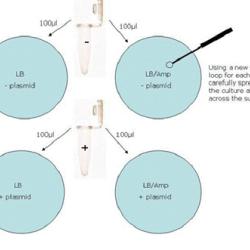Source Institutions
Source Institutions
Add to list Go to activity
Activity link broken? See if it's at the internet archive

In this activity related to plant biotechnology, learners transform a strain of E. coli using green fluorescent protein from a bioluminescent jellies. This lab will help learners understand recombinant DNA techniques, including the transformation procedure using the heat shock method, the uses of marker or reporter genes in molecular biology experiments and how to screen for a gene of interest, how DNA can be transferred to another organism and therefore change the observable characteristics of that organism, and how to calculate transformation efficiency. Learners will also become familiar with sterile technique and decontamination procedures to safely handle bacteria. Although the E. coli strain used in the experiment is non-pathogenic, it's important to emphasize proper safety precautions and adult supervision is highly recommended. This resource also contains background information, safety tips, and questions with answers for learners.
- 1 to 7 days
- 1 to 7 days
- Over $20 per group of students
- Ages 11 - adult
- Activity, Demonstration, Experiment/Lab Activity, Lesson/Lesson Plan
- English
Quick Guide
Materials List (per group of students)
- Disposable gloves
- Safety goggles
- Waterproof marker
- Microtube rack
- 6 disposable pipettes
- 6 disposable inoculating loops
- Bacterial waste container
- Foam cup with crushed ice
- 2 plates with LB Medium
- 2 plates with LB medium + ampicillin
- Microtube filled with 50 mM CaCl2
- Microtube filled with Luria-Bertani broth
- Squirt bottles containing 10% bleach
- 20-µl micropipette and tips for instructor use only
- Water bath (with floating tube racks)
- Plates with E. coli cells streaked out and grown overnight
- pGREEN plasmid (0.005 µg/µl)
- Crushed ice
- Distilled water
- 37°C incubator
- Parafilm
- UV light
- Container with 10% bleach for sterilization of all items that come into contact with the bacteria
- You will need a large container with 10% bleach solution to contain all used disposable pipets and loops and to sterilize the petri dishes
Subjects
-
Engineering and Technology
-
Engineering
- Bioengineering/Biomedical Engineering
-
Technology
- Agriculture and Biotechnology
-
Engineering
-
Life Sciences
-
Cells
- Cell Structure and Function
- Cell Division
-
Diversity of Life
- Animals
- Viruses and Bacteria
-
Heredity and Genetics
- DNA Structure and Function
- Genetic Engineering
-
Cells
-
Physical Sciences
- Chemistry
-
Vibration and Waves
- Light and Optics
-
Mathematics
-
Data Analysis and Probability
- Data Analysis
- Data Collection
- Data Representation
- Number and Operations
-
Data Analysis and Probability
-
The Nature of Science
-
The Scientific Process
- Conducting Investigations
- Gathering Data
- Formulating Explanations
- Communicating Results
-
The Scientific Process
Informal Categories
- Animals
Audience
To use this activity, learners need to:
- see
- see color
- read
- touch
Learning styles supported:
- Involves teamwork and communication skills
- Involves hands-on or lab activities
Other
Components that are part of this resource:
- Student Activity: Transformation of the bacterium E. coli using a gene for green fluorescent protein
This resource is part of:
Access Rights:
- Free access
By:
- Stephens, Janice ; Leach, Jan
Rights:
- All rights reserved, The American Phytopathological Society, 2011
